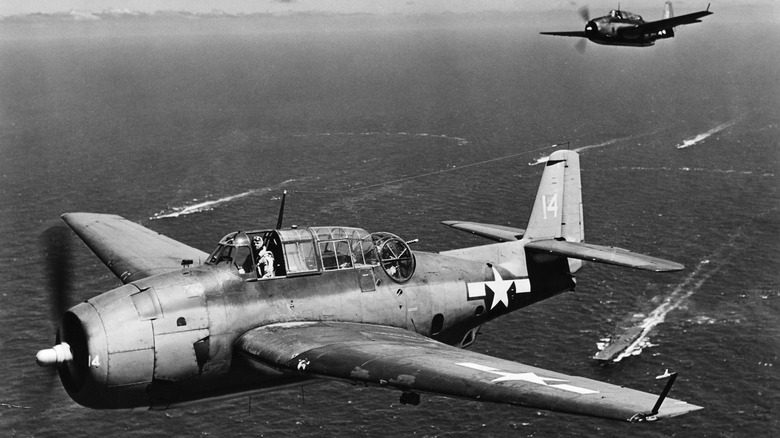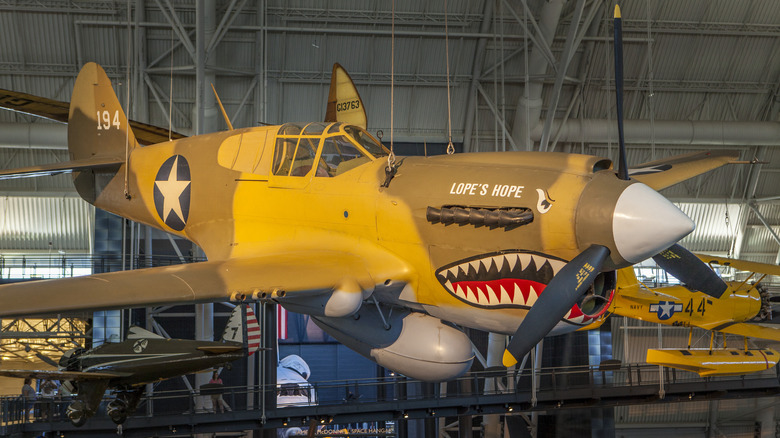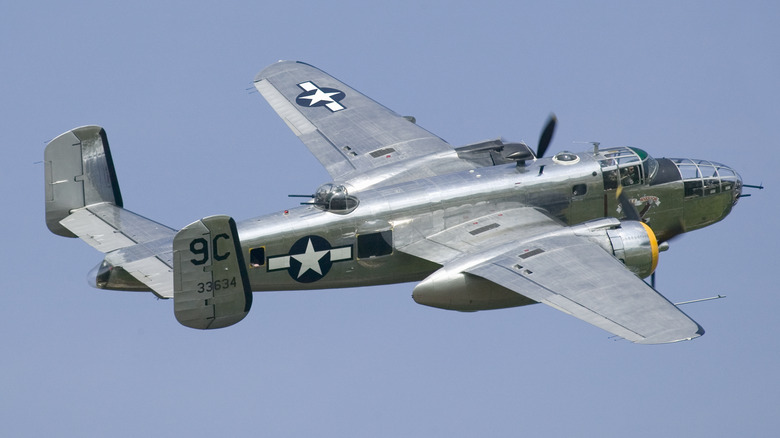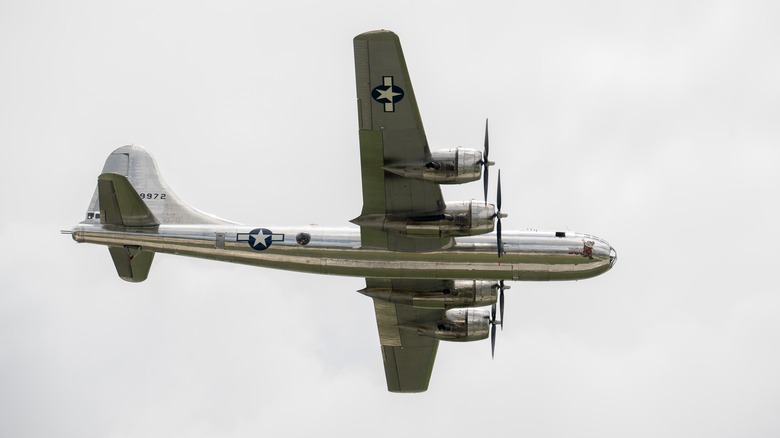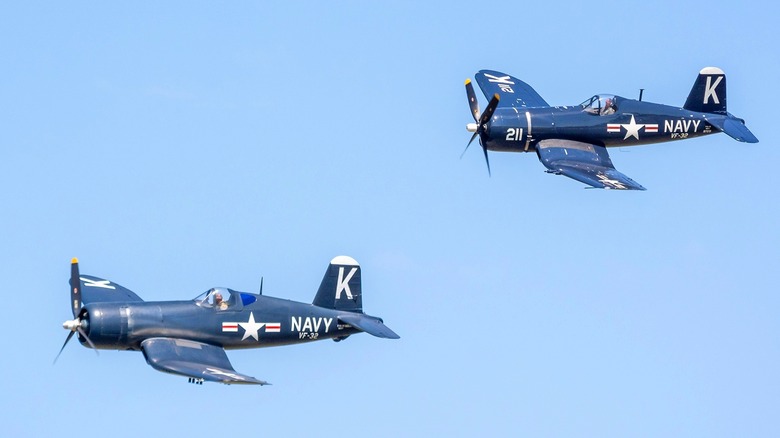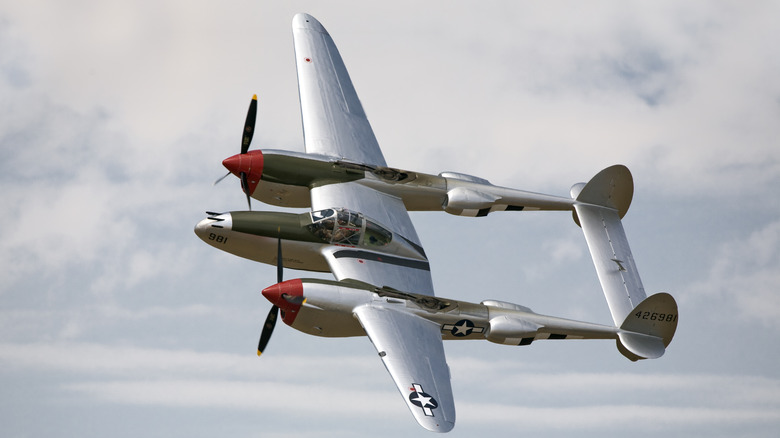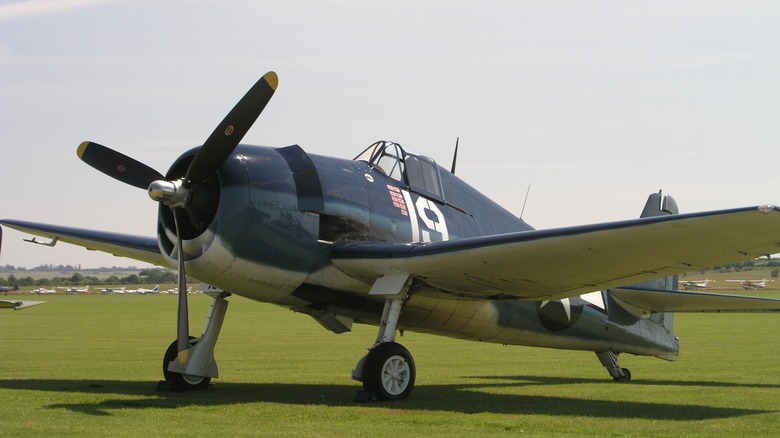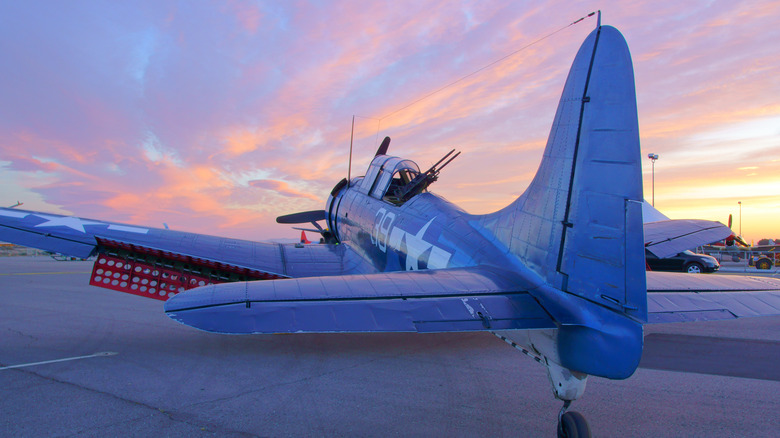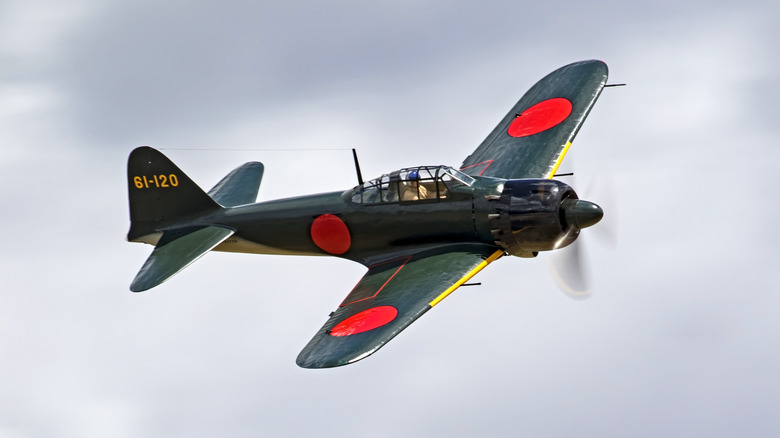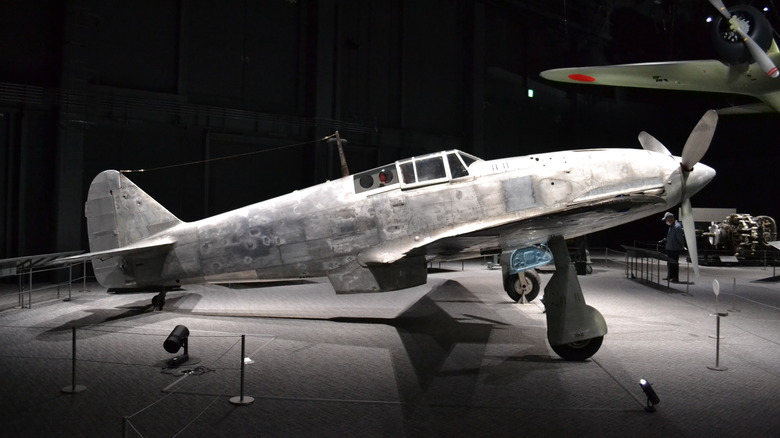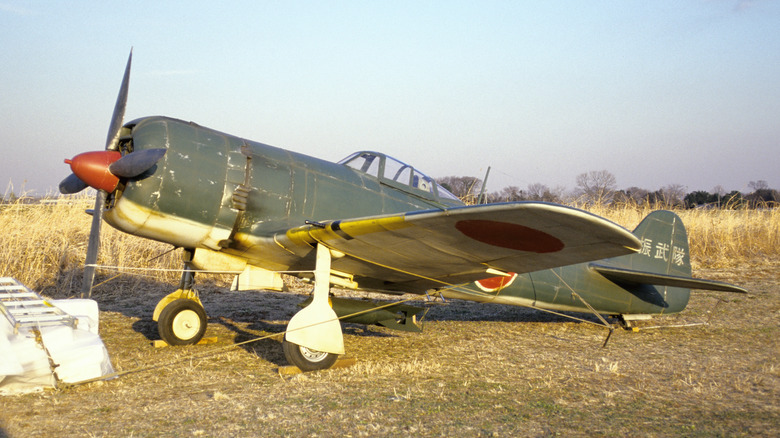Ten Of The Most Notable Planes To Fight In The Battle Of The Pacific
The Pacific Ocean may be the most enormous battlefield in the history of warfare. During World War II, the vast Pacific proved the battlefield of two of the world's greatest navies. The aircraft carrier had supplanted the battleship as a nation's premier force projection tool in the years between the two World Wars. With naval warfare taking to the sky, it was inevitable that pilots and carrier-based aircraft would decide the fate of Oceania, setting up a power structure in the Pacific that continues today. Like the aircraft that fought in the Battle of Britain, governments devoted enormous resources to gaining air supremacy.
The Japanese surprise attack on Pearl Harbor was the kickoff of the conflagration. Severely depleted but not down for the count, the United States Navy struck out from its bases in Hawaii in an island-hopping campaign that would take them to the very shores of the Japanese home islands. Famous for its bloody land invasions, the island-hopping strategy nonetheless relied on gaining and keeping air superiority. It allowed naval-based air forces to complete missions from protecting naval assets, preparing islands for invasion, launching revenge attacks, and even initiating an airborne assassination.
Let's examine some of the legendary aircraft that swirled in the skies over the Pacific Ocean in one of the most enormous campaigns in history.
Curtiss P40 Warhawk
Even before the attack on Pearl Harbor pulled the United States into World War II, a team of Americans were flying fighter planes in the Asian theatre of war. The P40 was the primary weapon of the Flying Tigers, a unit of American volunteers that fought the Japanese over the skies of China and Burma in the cockpits of the P40 Warhawk. The American squadron proved valuable despite predating America's official entry into the war. They flew air cover, transported supplies, shot down Japanese fighters, and protected the Chinese capital of Chungking.
The P40 is one of the lesser-known heroes of the Second World War. Primarily a late interwar plane, it was one of the most prominent fighters upon the commencement of hostilities in 1939. Armed with six .50-cal machine guns in the wings and capable of carrying up to 700 pounds of bomb payload, the Warhawk was classified as a pursuit plane (hence the P, a standard vocabulary before planes began getting the F designation for fighter post-war), but equally capable of limited ground attack.
An Allison V10 engine powered the P40 to a maximum speed of 362 miles per hour and a cruising speed of 235 miles per hour. The vehicle had an 850-mile range and a 30,000-foot altitude ceiling. Though the Warhawk was land-based, unlike many of the other Pacific planes of the American Navy, its early experience brought valuable tactical information to the pilots who would launch from carriers.
North American Mitchell B-25
Another land-based plane that made an outsized impact on the war was the North American B-25 Mitchell bomber. A medium bomber from early in the war, the B-25 nonetheless played a role in seeking revenge for the bombing of Pearl Harbor. The U.S. Navy was far from ready to initiate a full-scale attack on Japan, but striking at the heart of Tokyo would be an enormous propaganda victory.
Under the command of Lieutenant Colonel James Doolittle, a squadron of B-25s took off from the USS Hornet on a punitive bombing raid to Tokyo. Nominally out of range, the B-25s had to be heavily modified to make the short takeoff from an aircraft carrier. Fuel for the mission was at such a premium, and landing the medium bombers on an aircraft carrier was so tricky that the squadron had to crash land in China rather than return to the fleet after the mission. Doolittle's raid successfully dropped bombs on Tokyo in April 1942, just a few months after Pearl Harbor.
With a crew of six, a dozen or more forward-facing machine guns, and a pair of 1,700 horsepower Wright engines, the B-25 served in all theaters of the war, including a stellar career in the Pacific. It wreaked havoc on ground forces, submarines, and surface craft. Pilots became especially adept at skip-bombing or launching bombs at such a flat trajectory that they skipped across the water's surface before slamming into enemy ships.
Boeing B-29 Superfortress
The B-29 Superfortress had more impact than any single vehicle deployed during the Second World War. Though thousands, if not millions, of planes, trains, and automobiles fought and met their end during the world, the Superfortress put a full stop to the world's most significant conflict. This is because it was a Superfortress that infamously fired the final shots of the war: the atomic bombs that decimated Hiroshima and Nagasaki, forcing Japan to surrender in 1945.
But the quad-engined heavy bomber did a lot more than that. First flying in 1942, the Boeing Superfortress lived up to its name as it bristled with eight remote-controlled .50-cal machine guns, two additional human-operated .50-cals, a tail cannon of 20 mm, and an incredible 20,000-pound bomb payload. But what made the Superfortress so critical to the war effort in the Pacific was its range. With four Wright R-3350s making 2,200 horsepower each, the Superfortress had a range of 3,700 miles. As the entire objective of the Pacific campaign was to get close enough to the Japanese home islands to strike, the range of the B-29 was critical in delivering the final blows of World War II.
Though the Superfortress helped end the war, its career continued. Less than a decade later, it saw service as a front-line bomber during the Korean War. A Superfortress also served as the launch platform for Chuck Yaeger's Bell X-1, "Glamorous Glennis," during its sound barrier-breaking mission.
Vought F4U Corsair
One of the most distinctive-looking aircraft of the war, the Corsair, was beloved by its pilots. Its curious bent wings result from its oversized propeller, which, at four meters long, would strike the ground if installed in a typical flat-winged aircraft. By the war's end, the Corsair had accrued an incredible 11:1 kill ratio. For every Corsair shot down by the Japanese, pilots scored 11 kills. Throughout the war, Navy pilots scored over 2,000 aerial kills to the loss of 189 Corsairs.
A powerful Pratt and Whitney R2800 double-wasp engine with 2,650 horsepower drove the Corsair to a maximum speed of 446 miles per hour with a 1,500-mile range. Its armament included six .50-cal machine guns, four .79-inch cannons, and a mix of either 4,000 pounds of bombs or eight five-inch rockets. Japanese troops called the Corsair "Whistling Death" for the sound it made when on attack runs at low altitudes. Like the Superfortress, the Corsair proved advanced enough to enjoy a career that lasted into the jet age. It saw action in the skies of Korea, even shooting down a pair of MiG 15 fighter jets over MiG Alley in 1950. The Corsair remains a favorite of World War II enthusiasts and historians. Despite between 12,000 and 15,000 rolling off the production line, only about a dozen remain flying today.
Lockheed P-38 Lightning
The P-38 Lightning is one of the most bizarre planes of World War II, thanks to its interesting double-tail configuration. It also sported two Allison V-1710 engines, each making 1,475 horsepower. The Lightning proved a favorite amongst U.S. Army Air Force aces with a maximum speed of 414 miles per hour, a cruising speed of 275 miles per hour, and a maximum range of 1,300 miles. The P-38L could accommodate a pair of 300-gallon drop tanks, increasing an already impressive range. The L model did not appear in the battlespace until June 1944.
Seven of the eight top Army aces in the Pacific theater achieved their kills from behind the controls of the Lightning. It was an excellent long-range escort, bomber, ground attack plane, and an adept dogfighter. It sported a powerful armament with a quartet of .50-cal machine guns supplemented by a 20 mm cannon. The Lightning's excellent range and firepower came in handy on another mission of vengeance. When Admiral Chester Nimitz learned that Admiral Yamamoto, the mastermind behind the attack on Pearl Harbor, would be visiting troops on Bougainville, he dispatched a flight of P-38s to shoot down the plane. The Lightning was the only fighter with the range for the job.
Eighteen P-38s dead-reckoned a rendezvous with Yamamoto's G4M Betty bomber and its escort of a half-dozen Zeros. They pounced, downing the plane and sending Yamamoto to a watery grave, thus securing a place in aviation history.
Grumman F6F Hellcat
The Grumman's Hellcat, a carrier-based fighter aircraft, emerged as the workhorse of the United States Navy during the Pacific campaign. One of the top fighters of the war, its development, from the drawing board to the carrier deck, in less than 18 months was a remarkable feat achieved by aviation engineers who worked with Hellcat's predecessor, the F4F Wildcat, to enhance the design. This historical significance of the Hellcat in the Pacific campaign is a testament to its enduring legacy
Equipped with heavy armor plate and a 2,000 horsepower R-2800-10W engine, the Hellcat was initially envisioned as an answer to Japan's ultra-competent A6M Zero. Hellcats amassed an incredible record of 5,155 enemy aircraft destroyed in fewer than two years of combat operations.
The Hellcat was not the fastest plane in the sky, but what it sacrificed in speed, it made up in rates of climb and maneuverability. Foldable wings allowed more Hellcats to be stored within the bowels of an aircraft carrier. In addition to dogfighting duties, the Hellcat could launch limited ground attacks with rockets and bombs.
Douglas SBD Dauntless Dive Bomber
The SBS Dauntless is one of the most overlooked planes of the Pacific campaign. Anti-ship capability is a crucial component of a naval aerial war. That's where the Dauntless comes in. This dive bomber did more to sink Japanese shipping than any other bomber during the war. It also achieved the honor of being the first American aircraft to sink a Japanese ship during the war, just three days after Pearl Harbor.
The Dauntless was operated in tandem by a crew of two men: a pilot and a radio operator/navigator/tail gunner. The Wright R-1820-60 engine packed 1,200 horsepower for a relatively slow maximum speed of 255 miles per hour and a cruising speed of 185 miles per hour. Two .50-cal forward-firing machine guns and two .30-cal rear-facing machine guns provided defensive armament, but it was the 1,000 pound bomb load that made the Dauntless dangerous.
The Dauntless's shining moment came at the Battle of Midway, a turning point in the Pacific War during which the two main carrier fleets of the belligerent nations faced off in a slugfest. The dive bombers sank a total of four Japanese carriers, putting Japan on its back foot for the rest of the war.
Mitsubishi A6M Zero
A testament to the ingenious design, the Mitsubishi A6M Zero was one of World War II's most famous fighter planes. One of the earliest carrier-based aircraft able to go toe-to-toe with heavier and larger ground-based fighters, Japan began manufacturing Zeros in 1939, with their first operational deployment coming in 1940.
The Zero fought the entire war as one of Japan's primary air superiority fighters. It saw action at Pearl Harbor, Midway, and even in the last-ditch defense of Japan's home islands. Powered by a 14-cylinder Nakajima NK1C Sakae engine, the Zero reached a top speed of 331 miles per hour with an altitude ceiling of 32,810 feet.
American fighters initially had a difficult time countering the ultra-maneuverable Zero. The Flying Tigers encountered them in the skies over China and found them light, fast, and difficult to shoot down. However, one reason for their maneuverability was a lack of armored plating and self-sealing fuel tanks. As American planes developed more powerful engines and armament, it evened out the playing field. By the end of the war, many Zeros were converted to use as kamikaze vehicles meant to destroy ships in suicidal attacks.
Kawasaki Ki-61
The Ki-61, code-named Tony, was a single-seat interceptor active for the Imperial Japanese military between 1942 and 1945. It received a German Mauser 20mm cannon shipped to Japan surreptitiously via submarine. It also sported a pair of 12.7 mm machine guns and two 250-kilogram bombs.
Most Japanese aircraft were destroyed in the post-war era, but one Ki-61 airframe remains in a museum. Unlike the Zero, the Ki-61 sported self-sealing fuel tanks and armor plates fitted behind and beneath the pilot. For power, an inverted V12 pushed it to a maximum speed of 361 miles per hour and a cruising speed of 215 miles per hour.
The Ki-61 was used by the Imperial Japanese Army but saw significant action in the Pacific theater as a next-generation Zero-type fighter. It saw particular success against the B-29, as it could fight at the altitudes the Superfortress was capable of. Japan produced a total of 1,380 Ki-61s.
[Featured image by 先従隗始 via Wikimedia Commons | Cropped and scaled | CC0 1.0 Universal]
Nakajima Ki-84
The Ki-84 was a highly respected late arrival to the theater. It came too late to turn the tide of the war for Japan, but it remains a competent addition to the Japanese Army Air Forces. The fighter operated between 1943 and 1943. It was powered by an 18-cylinder air-cooled radial Nakajima Ha-45-21 18, making just shy of 2,000 horsepower.
Armed with a pair of 20mm cannon and a pair of 12.7 mm machine guns, the "Frank," as it was known, had a 1,000-mile range and a top speed of 392 miles per hour. Some consider Frank the best Japanese fighter fielded during the entire war. It was Japan's fastest offering, but not enough to keep up with the plethora of American-fielded machines and their production numbers.
A single Ki-84 survives today despite the fact that 3,514 were produced during the war. American forces captured it at Clark Field in the Philippines in the waning days of the war, and it resides at the Chiran Peace Museum in Kagoshima, Japan.
[Featured image by contri via Wikimedia Commons | Cropped and scaled | CC BY-SA 2.0]
